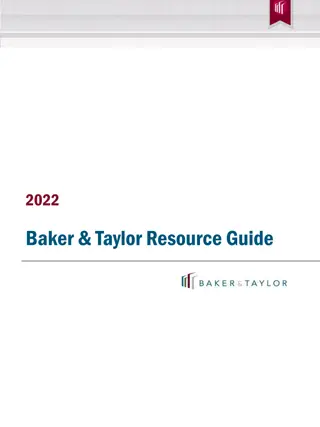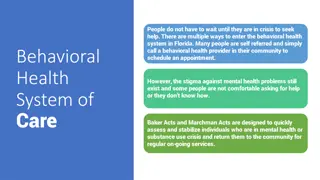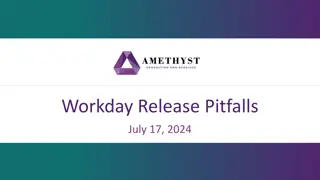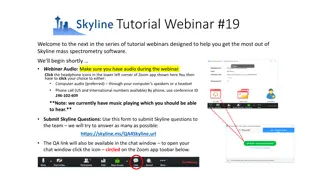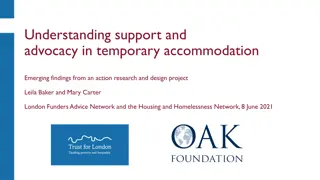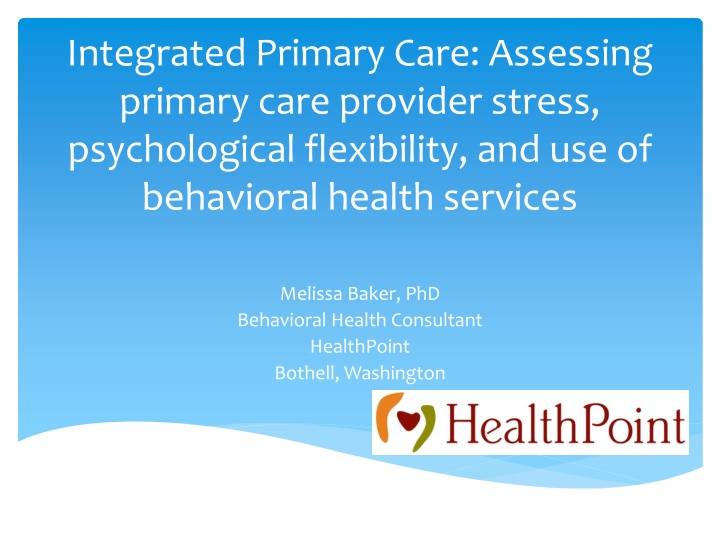
Assessing Primary Care Provider Stress and Behavioral Health Services
Explore the impacts of stress on primary care providers and the integration of behavioral health services. Learn about efforts to improve psychological flexibility and enhance well-being in a fast-paced healthcare setting.
Download Presentation

Please find below an Image/Link to download the presentation.
The content on the website is provided AS IS for your information and personal use only. It may not be sold, licensed, or shared on other websites without obtaining consent from the author. If you encounter any issues during the download, it is possible that the publisher has removed the file from their server.
You are allowed to download the files provided on this website for personal or commercial use, subject to the condition that they are used lawfully. All files are the property of their respective owners.
The content on the website is provided AS IS for your information and personal use only. It may not be sold, licensed, or shared on other websites without obtaining consent from the author.
E N D
Presentation Transcript
Integrated Primary Care: Assessing primary care provider stress, psychological flexibility, and use of behavioral health services Melissa Baker, PhD Behavioral Health Consultant HealthPoint Bothell, Washington
Objectives A brief review of HealthPoint s integrated behavioral health program Discuss Provider Study Present data from study Discuss lessons learned and interventions implemented
HealthPoint Founded in 1971 Largest Federally Qualified Health Center in King County Washington Level 3 Patient-Centered Medical Home 12 locations Integrated Medical, Dental, Pharmacy 2 School Based Clinics Started Behavioral Health Program in 2000 BHC as each site; plus interns/practicum students
Integrated Behavioral Health 80% of PCPs visits are psychosocial driven Primary Care Behavioral Health Model (PCBH) Robinson & Reiter, 2015 Population-based care model Consultant to PCMT Brief visits Collaborative Catch patients in a teachable moment Shared practice space Clinical: Tx plan; Shared EBPs Billing Practice Change (5th& 6th) Care team: One stop shop Organization support
Why do this study? Working in primary care is very complicated, fast paced, and dynamic = STRESSFUL Only 40% of US physicians are PCPs Of younger PCPs, 30% plan to leave PC within 5 years Of older PCPs, 27% plan to retire AND 25% to leave PC within 5 years High burnout in primary care Why? Build professional resiliency and psychological flexibility
Why do this study? Focus on integration How can BHCs support/assist PCPs with their own well- being to reduce the burden? PCPs value the work- How do we reconnect them to values? What do PCPs value within the PCBH model? As a BHC, how can I better . Teach Collaborate Reach the population
Study Design Phase I Online Survey to medical providers Phase II 4 BHC providers paired with 2 medical providers (MD, DO, NP) BHCs work side by side with PCMT for 1 full week Goal to collaborate on as many patients as feasible Direct patient care Indirect patient care
Provider Study Primary Care Provider Stress- Checklist 37 items 6 stress domains: patient interactions, practice management, administrative issues, education/learning, relationships with colleagues, and work-life balance Total score; domain score PCP AAQ-II 20items AAQ-II O Donohue s Behavioral Health Satisfaction Survey Likert scaling about BHC services
Provider Demographics 57 providers (50 completed entire survey) Majority (N = 37) MDs Majority early in their careers 0 5 years = 22 6 10 = 11 11 15 = 10 16+ = 13
Provider Study Increases in flexibility, stress levels decrease PCP-SC (p < .01; r = -.52) with PCP-AAQ Increases in flexibility, stress levels decrease PCP-SC (p < .01; r = .60) with AAQ - II Providers satisfaction with BH increases, their stress decreases PCP-SC (p < .01; r = -.40) with BH satisfaction survey PCP-AAQ accounted for 27% of the variance (p < .000) Control for degree type (i.e., MD, DO, NP), the variance is 30%
BH Satisfaction 100% satisfied with BH 34 = Strongly Agree (68%); 16 Somewhat Agree (32%) 100% recommend having BH services 47 = Strongly Agree (94%); 3 = Somewhat Agree (6%) 100% believe referral process easier 48 = Strongly Agree (96%); 2 = Somewhat Agree (4%) 84% agree patients more compliant 17 = Strongly Agree (34%); 25 = Somewhat Agree (50%) 100% agree having BH makes job easier 45 = Strongly Agree (90%); 5 = Somewhat Agree (10%)
Implications Psychological flexibility in PCPs Important to assist PCPs in building psychological flexibility Decrease stress, burnout Longevity! PCPs like having BHC services How do you discuss psychological flexibility with medical providers? Post- study presentation to providers State versus trait Brainstorming began . Provider meetings Online modules Handouts
Implications ACT Bullseye Activity Quarterly at PCP meetings Timeline activity PCP group Teach Mindfulness Online modules on mindfulness exercises Choice Point/Matrix Activity Fully integrated BHCs
Provider Statement 1stjob ARNP- I really liked the bullseye activity. As a new provider I felt the pressure ! I came to community health for the mission and found myself lost in productivity goals and cursing the electronic medical record. This activity helped me think about deep down what is important to me. It opened my eyes to the imbalance I had created in my work life, but also in other life domains.
Acknowledgement HealthPoint Bothell David Bauman, PsyD Bridget Beachy, PsyD


